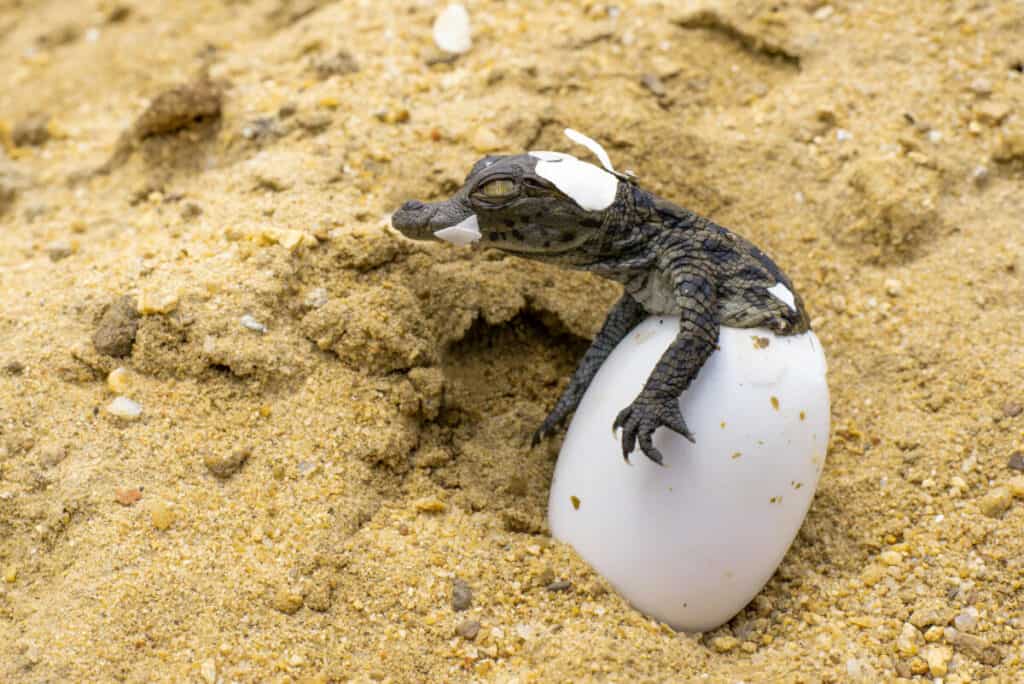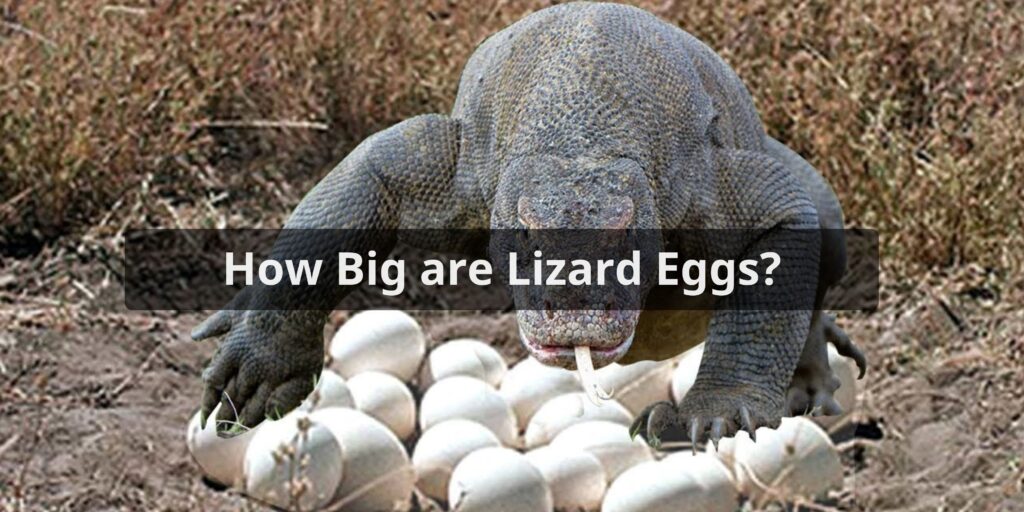Lizards are a diverse group of reptiles that can be found all over the world. There are over 6,000 known species of lizards, ranging dramatically in size, color, behavior, and reproductive strategies. When it comes to lizard egg size specifically, there is a huge amount of variation between different lizard species. Here is an overview of lizard egg sizes and the factors that influence them.
Average Lizard Egg Size by Species
| Lizard Group | Egg Size Range |
| Geckos | 12-25 mm long |
| Iguanas | 35-50 mm long |
| Skinks | 10-35 mm long |
| Monitors | 30-70 mm long |
| Tegus | 40-50 mm long |
| Chameleons | 10-30 mm diameter |
| Anoles | 6-15 mm long |
| Agamas | 15-35 mm long |
| Bearded Dragons | 20-30 mm long |
- Geckos – Most geckos lay 1-2 hard-shelled eggs at a time that are about 12-25 mm long. For example, leopard gecko eggs are usually 20-30 mm long.
- Iguanas – Iguanas lay clutches of 20-80 eggs at a time. The eggs are about 35-50 mm long.
- Skinks – Skinks are a highly diverse lizard family. Most skinks lay small clutches of 1-10 eggs that are 10-25 mm long. Some larger skinks can lay eggs up to 35 mm long.
- Monitors – Monitor lizards are large lizards that lay clutches of 7-60 eggs. Monitor egg size ranges from 30-70 mm long depending on the species.
- Tegus – Tegus are lizards from South America. They lay clutches of 8-25 eggs that are 40-50 mm long.
- Chameleons – Chameleons lay small clutches of 4-40 eggs at a time. The eggs are quite round and 10-30 mm in diameter.
- Anoles – Anole lizards lay one egg at a time, each 6-15 mm long.
- Agamas – Agamas are another diverse lizard family. Their eggs are usually 15-35 mm long laid in clutches of 2-35.
- Bearded dragons – Bearded dragons lay 20-50 eggs per clutch. The eggs are 20-30 mm long.
As you can see, lizard egg sizes range dramatically from just 6 mm long in some species to over 70 mm long in the largest lizards. But what influences this huge variation in lizard egg sizes?
Factors Affecting Lizard Egg Size

There are several key factors that explain why some lizards lay tiny eggs while others lay eggs nearly the size of a ping pong ball:
Lizard size – In general, larger lizards lay larger eggs. Small geckos lay tiny eggs while huge monitor lizards lay eggs 5-10 times bigger. Lizard egg size correlates strongly with the overall size of the adult lizard’s body.
Clutch size – Lizards that lay large clutches of eggs tend to have smaller individual eggs than lizards that lay just 1-2 eggs at a time. For example, iguanas lay 80 eggs per clutch but each egg is small. Geckos lay just 2 eggs but each one is bigger. This tradeoff allows the total reproductive investment to remain balanced.
Egg retention – Some lizards retain the eggs inside their body for an extended period of time, allowing the embryos to undergo significant development before the eggs are laid. These species often have relatively small eggs since the embryos are already well-developed. Other lizards lay their eggs immediately after fertilization when the embryo is still very small, which requires a larger egg.
Parental care – If a lizard provides extended care for its eggs by defending, incubating, or provisioning them, the eggs can be smaller since they have a better chance of survival. Lizards that abandon their eggs quickly after laying often have larger eggs to give embryos a boost.
Environment – Lizards in cold climates tend to lay fewer, larger eggs while tropical lizards often lay many smaller eggs. The environment helps shape optimal egg size for embryonic development.
Egg shape – Most lizard eggs are elliptical rather than spherical, so length and width measurements can vary based on the typical shape for a given species. Spherical eggs tend to be relatively small.
Evolutionary history – Related lizard species often share similarities in optimal egg size based on their evolutionary relationships. Egg size is an adaptation that evolves over time.
So in summary, the incredible diversity of lizard reproductive strategies leads to huge variation in egg size across species. Tiny gecko eggs and massive monitor lizard eggs reflect adaptations to body size, clutch size, parental care, environment, and evolutionary history. There is no single best lizard egg size – each species has adapted to produce eggs that maximize reproductive success in their particular ecological niche. The range spans from just 6 mm to over 70 mm, with most lizard eggs falling between 10-40 mm in length. By examining lizard egg size, we gain insight into the selective pressures shaping their reproductive biology and development.
Conclusion
In conclusion, lizard egg sizes vary tremendously based on the species, ranging from just a few millimeters long in small lizards to over 70 mm in the very largest lizard species. Factors like adult body size, clutch size, egg retention, parental care, environment, egg shape, and evolutionary history all influence the optimal egg size for a given lizard. There is immense diversity in lizard reproductive strategies that is reflected in the huge variation in egg sizes across this amazing group of reptiles. Examining lizard egg size provides insight into the selective pressures that have shaped their reproductive biology over evolutionary time.
FAQs About How Big are Lizard Eggs
Do the size of lizard eggs vary between different species?
Yes, lizard egg size varies significantly across species. Smaller species tend to have smaller eggs, while larger species lay larger eggs. This diversity is due to evolutionary adaptations to specific environments and reproductive strategies.
What factors can influence the size of lizard eggs?
Several factors influence lizard egg size, including maternal size, metabolic rate, clutch size, and habitat conditions. Limited resources, predation risks, and environmental constraints also play a role in determining egg size.
Are there any lizard species with exceptionally large or small eggs?
Yes, for instance, the Komodo dragon lays relatively large eggs, while some gecko species lay tiny eggs. These variations reflect the diverse reproductive strategies and environmental adaptations of different lizard species.
How does the size of lizard eggs impact their survival?
Egg size impacts survival, as larger eggs tend to have more resources for embryonic development. However, larger eggs might be more vulnerable to predation or less suitable for certain environments, leading to a trade-off between size and survival.
Are there any patterns in egg size based on habitat or climate?
Yes, lizards in cooler climates may lay larger eggs with thicker shells to provide better insulation and protection. In warmer climates, smaller eggs might be favored to reduce heat retention. These adaptations help ensure successful development.
Do larger lizard species tend to lay larger eggs?
Yes, generally larger lizard species tend to lay larger eggs. This is known as the “Reproductive Size Advantage Hypothesis.” Larger mothers can invest more resources into producing larger eggs, enhancing the chances of their survival and growth.
Can you provide examples of specific lizard egg sizes?
Certainly, a leopard gecko’s egg is about 2.5 cm long, while a green iguana’s egg can reach 5 cm. The size varies widely; for example, the eggs of the smallest chameleon species can be less than 1 cm, whereas those of the largest monitor lizards can exceed 8 cm.
How do lizard egg sizes change as the species evolve?
Egg size can evolve based on environmental pressures. Species in environments with limited resources might evolve smaller eggs to maximize the number of offspring. Conversely, in stable or resource-rich environments, larger eggs might evolve to invest more in each offspring’s success.
Are there any predators that target lizard eggs due to their size?
Yes, many predators target lizard eggs, often due to their size and vulnerability. Snakes, birds, mammals, and other reptiles can raid nests for eggs. The size of the eggs can influence the range of potential predators and their success in accessing the eggs.



